Intriguing Insights into Sharks: A Deep Dive
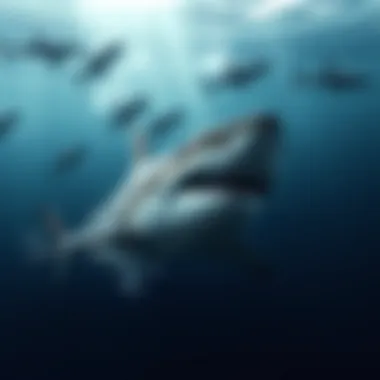
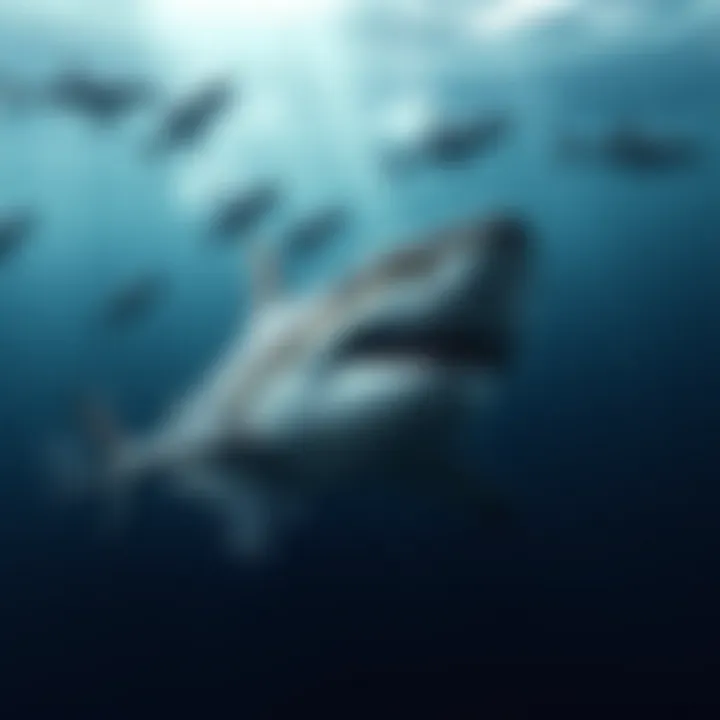
Intro
Sharks are more than just toothy predators that glide silently through ocean depths. They are a vital thread in the fabric of marine ecosystems, carrying a rich history that rhinoceros times old. Many surfboarding enthusiasts, whether seasoned veterans of the waves or greenhorns eager to ride their first tide, share a connection to these majestic creatures. Understanding sharks goes beyond fearing their bite; it's about appreciating their integral role in the oceanic realm.
As we unravel this tapestry of knowledge, we will explore several aspects: their evolutionary journey, the delicate balance they maintain in their habitats, and their surprisingly close ties to surf culture. The ocean’s sharks, with their haunting beauty and ancient lineage, play a part in every aquatic adventure—from the tranquil spacing out on a surfboard awaiting a wave to the thrill of paddling out into the depths.
With every swipe of the surfboard, there's a tale that whispers beneath the surface. Surfers have long recognized the importance of respecting the ocean and everything dwelling within it. So, whether you're eyeing the latest surf gear or honing your technique, gaining insights into the sharks’ world offers a perspective that enriches the entire surfing experience.
Prelude to Sharks
When it comes to marine life, sharks often stand out as some of the most misunderstood yet fascinating creatures. Their sleek bodies and powerful presence capture the imagination of many, but their true importance within oceanic ecosystems often goes unnoticed. Recognizing the role sharks play in maintaining the health of marine environments is critical—it's not just about their place in the food chain, but also about their contributions to biodiversity and ecosystem balance.
Significance of Sharks in Marine Ecosystems
Sharks are more than just apex predators; they are a keystone species in many marine environments. By regulating the populations of their prey, they help maintain a balance that supports diverse marine life. For instance, when shark populations decline, it can lead to an overabundance of smaller fish species. This overpopulation then impacts the health of coral reefs and other marine habitats. Such a domino effect underscores the intricate connections within ecosystems where sharks reside.
Moreover, sharks contribute to nutrient cycling in the ocean. When they hunt, they often leave behind remnants that serve as food for other organisms. This practice underscores their role in supporting a wide array of marine life, which ultimately benefits fishermen and coastal economies.
In addition to their ecological significance, the presence of sharks in a region can attract ecotourism, drawing enthusiasts eager to witness their majesty in the wild. For surfers, understanding the behavior and presence of sharks in surf zones is crucial, not just for safety, but for appreciating the interconnectedness of all ocean residents.
Cultural Perceptions of Sharks
The way sharks are perceived culturally varies widely across the globe, from being seen as symbols of fear to being revered as powerful creatures. Films like "Jaws" have painted sharks in a negative light, focusing on their predatory nature and exacerbating myths. This portrayal can lead to public misunderstanding and fear, causing unwarranted anxiety about shark encounters.
In contrast, many cultures view sharks positively. Indigenous communities often hold them as totems, symbols of strength, or pivotal figures in creation stories. Following the tradition of storytelling, sharks embody resilience and adaptability, traits that resonate deeply with those who respect the ocean.
Interestingly, the dichotomy in how society views sharks can significantly impact conservation efforts. A better understanding of their true nature and behavior can shift narratives, leading to greater acceptance and protection initiatives. By fostering an appreciation for sharks, we can cultivate a more effective discourse around their conservation, ultimately ensuring these majestic creatures continue to thrive in our oceans for generations to come.
"Sharks have been swimming in our oceans for over 400 million years, adapting and evolving in ways that continue to captivate researchers and marine enthusiasts alike."
As we delve deeper into the article, we will explore the evolutionary history of sharks, their anatomical features, and the behaviors that inform how they interact with their environment and surfboarding enthusiasts alike.
Evolutionary History
Understanding the evolutionary history of sharks is essential for grasping their role in marine ecosystems today. These creatures have been around longer than both dinosaurs and trees, making their narrative a compelling tale of survival and adaptation. The examination of sharks’ evolutionary background not only illuminates their biological significance but also offers insights that can be crucial for conservation efforts. By peeling back the layers of their past, we can better understand the threats they face today, especially with the increasing pressures from human activities.
Origins of Sharks
The story of sharks dates back over 400 million years. They first emerged during the Devonian period, a time when Earth’s oceans were teeming with a variety of marine life. Sharks are believed to have evolved from earlier fish-like ancestors known as placoderms. These ancient creatures laid the groundwork for what would become the diverse array of shark species we see today.
Interestingly, the adaptations sharks acquired over millennia helped them thrive in a world that changed dramatically. For instance, their cartilaginous skeletons made them lighter and more agile than bony fish. This flexibility allowed sharks to maneuver quickly through the water, a vital trait for both hunting and evading predators.
Several distinct lineages arose in the early stages of shark evolution, leading to unique patterns in their anatomy and behavior. Sharks have developed keen sensory systems—like the ability to detect minute electrical fields in the water—making them formidable predators in their habitats. The great white shark, for example, showcases these adaptations perfectly, blending strength and grace as it navigates the ocean depths.
Sharks Through the Ages
Throughout various geological epochs, sharks have weathered numerous mass extinctions, showcasing their resilience. Fossil evidence indicates that during the Mesozoic era, they diversified into forms that resemble many modern sharks. From the megatooth shark, known for its massive size and teeth, to the smaller, yet equally fascinating, dwarf lanternshark, the ancient oceans were a playground of grotesque yet captivating forms.
As we moved into the Cenozoic era, sharks adapted further to changing environments, leading to the emergence of nearly 500 species that exist today. Each species has carved its niche within the ecosystem—whether it be the great hammerhead with its distinctive head shape allowing for better hunting, or the whale shark, the largest fish in the sea, which filters tiny plankton for sustenance.
Sharks have survived through it all, including drastic climate changes and ecological shifts. Their evolutionary journey mirrors that of our planet itself, serving as a barometer for ocean health. By studying their fossil records and modern counterparts, researchers can draw links to past events, thus informing conservation strategies that are increasingly vital in a world dominated by anthropogenic changes.
"Understanding their past is crucial for protecting their future. Sharks are not just ancient survivors; they are key players in the ocean's health."
Anatomy of Sharks
Understanding the anatomy of sharks is not just a matter of exploring how these creatures are built; it’s like peeling back the layers of a well-crafted machine. Each component plays a pivotal role in their survival, hunting, and adaptation to marine environments. This section will delve into the intricacies of shark anatomy, spotlighting how their physical features give them an edge in the treacherous waters they inhabit.
Physiological Adaptations
Each physical characteristic of a shark is an adaptation that speaks to their evolutionary success. Sharktastic traits like skin structure, buoyancy mechanisms, and sensory systems equip these beings to traverse the ocean with efficiency and stealth.
Skin Structure
The skin of a shark is not just a protective barrier; it's built like a finely tuned instrument. Composed of formidably tough dermal denticles, this unique skin structure provides outstanding hydrodynamics. It helps minimize drag as they slice through water, making it an essential feature in their hunting prowess.
- Key Characteristic: The shape and texture of the dermal denticles reduce turbulence, allowing sharks to swim faster.
- Advantages: This adaptation makes sharks incredibly efficient swimmers, ideal for chasing down preys that might otherwise escape.
A potential downside, however, is the wear and tear these surfaces can endure from human intervention or pollution. Preserving these features is paramount for maintaining not just individual shark health, but the overall ecosystem where they serve pivotal roles.
Buoyancy Mechanisms


Buoyancy in sharks is remarkable; they have evolved a unique blend of physical features that eliminate the need for swim bladders, unlike many bony fish. Instead, a shark's liver is vast and filled with oils that help achieve neutral buoyancy, allowing them to maintain depth without significant energy expenditure.
- Key Characteristic: This method of buoyancy offers sharks the freedom to glide effortlessly, which is vital for long-distance migratory species.
- Advantages: With energy conserved, sharks can stay active for longer periods while hunting or roaming their territories.
The downside? Should a shark be subject to injury, particularly in the liver area, its buoyancy is directly compromised, affecting its survival.
Sensory Systems
Sharks are nothing short of sensory marvels. Their ability to detect electric fields through the ampullae of Lorenzini, combined with excellent olfactory capabilities, makes them top-tier hunters. These adaptations provide sharks the upper hand in locating prey, even in murky waters.
- Key Characteristic: Their keen sense of smell can detect a drop of blood in millions of gallons of water, directing them to potential meal options.
- Advantages: This extraordinary efficiency allows sharks to snatch opportunities in their environments before potential threats or competitors can.
However, one must consider that an over-reliance on certain sensory features can make them vulnerable should environmental changes affect their prey's behavior or distribution.
Diversity in Species
Sharks are a fascinating example of nature's diverse palette. From their varied sizes and shapes to holistic habitat variability, each species is a masterpiece of evolutionary design tailored for distinct marine niches.
Sizes and Shapes
Sharks come in myriad forms; from the petite dwarf lanternshark to the gargantuan whale shark, size and shape influence much more than aesthetics. These physical traits determine feeding strategies, reproductive behaviors, and habitat preferences.
- Key Characteristic: Various shapes provide different advantages in movement and hunting. For example, a streamlined body supports speed, while broader bodies may enable more effective ambushing tactics.
- Advantages: Size diversity allows sharks to occupy different ecological roles, maximizing their functionality within marine ecosystems.
Nevertheless, their form can also limit their behavioral patterns. A large shark, like the great white, might find itself hindered in confined spaces, lacking the agility of smaller species in certain environments.
Habitat Variability
Different species of sharks thrive in unique habitats, from deep ocean trenches to coastal lagoons. This remarkable adaptability signifies the evolutionary background and behavioral traits that shape how specific sharks interact with their surroundings.
- Key Characteristic: Habitat versatility allows diverse species to coexist within various ecosystems, optimizing resource use and minimizing competition.
- Advantages: Sharks can occupy various niches, ensuring they play crucial roles, from regulating fish populations to facilitating nutrient cycling in their habitats.
On the flip side, habitat change due to human factors, such as pollution or climate change, poses risks that could outstrip their adaptability.
Dietary Adaptations
Sharks have developed a range of dietary adaptations that reflect their predatory lifestyles. From filter-feeding behaviors to active hunting, their diverse diets highlight the complexity of their ecological niches.
- Key Characteristic: High-energy hunting strategies suit a predatory lifestyle, while some species, like the basking shark, have evolved to be filter feeders, showcasing their incredible adaptability.
- Advantages: This flexibility allows sharks to exploit an array of food resources, ensuring their survival across multiple environments.
However, this versatility can have drawbacks; prey scarcity could diminish food options for certain species, forcing them to adapt rapidly or face decline.
In summary, the anatomy of sharks is a complex web of adaptations that enable them to thrive in a variety of underwater ecosystems. Each physical trait is not merely a static feature; it's an evolving response to survival in a world fraught with challenges. By understanding these various anatomical aspects, we can foster a greater appreciation for sharks' vital roles in the oceans and promote their conservation for future generations.
Shark Behavior
Understanding shark behavior is crucial, not just from a marine biology standpoint but also for anyone involved in oceanic activities, especially surfboarding enthusiasts. The interaction between sharks and surfers can be profoundly affected by the behaviors exhibited by these magnificent creatures. Knowledge of how sharks hunt, form social structures, and migrate provides essential insights that can empower surfers to respect these animals and coexist with them in the ocean.
Hunting Techniques
Sharks are infamous for their hunting skills, which vary widely among species. They are equipped with highly evolved features that make them master predators in their environment. For instance, the great white shark employs a strategy known as breaching, where it launches itself out of the water to surprise its prey, often seals. Contrarily, the nurse shark utilizes a more stealthy approach, ambushing its prey from below, thereby making it difficult for smaller fish to escape once they are in its reach.
Here are some notable hunting techniques:
- Ambush Predation: Sharks such as the thresher shark are known to use their long tails as a whip to stun their prey.
- Cooperative Hunting: Certain species, like hammerhead sharks, have been observed hunting in groups, demonstrating an understanding of teamwork to enhance their chances of capturing prey.
- Sensory Detection: Sharks possess an acute sense of smell, being able to detect a drop of blood in the water from miles away. This olfactory sense, combined with their lateral line system that senses vibrations, aids them in locating prey even in murky waters.
The intricacies of these hunting techniques underline the importance not only of their role in the ecosystem but also the need for surfers to remain vigilant while in the water, particularly in areas known for shark activity.
Social Structures
Sharks have traditionally been thought of as solitary creatures. However, recent studies have highlighted that many species display complex social behaviors. For instance, blacktip reef sharks often gather in groups during specific periods, which might serve as a reproductive strategy or simply as a means of social interaction. Such behaviors can significantly influence their hunting strategies and environmental interactions.
Consider the following aspects of shark social structures:
- Hierarchical Relationships: Some shark species exhibit a pecking order, where the dominant individuals have better access to food and mating opportunities, impacting the overall population dynamics.
- Communication Methods: Sharks can communicate through body language and perhaps even subtle changes in body posture. This form of communication might help them coordinate during group hunting or during mating displays.
- Social Learning: Younger or less experienced sharks can benefit from observing and mimicking older or larger sharks, leading to enhanced survival and improved hunting success.
These social intricacies not only enrich the understanding of sharks but can also inform surfboarders about potential safety measures when they encounter groups of sharks in the water.
Migration Patterns
Sharks are known for their extensive migratory patterns, which can span thousands of miles. These migrations are often designed around breeding, feeding, and environmental changes. For surfers, being aware of these migratory behaviors is essential. For example, the white shark migrates from coastal waters to deeper oceanic areas, often in sync with seasonal changes in water temperature.
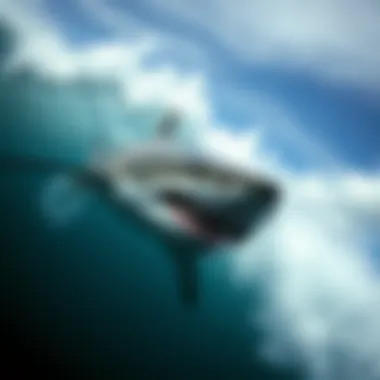

Notable points regarding shark migration include:
- Behavioral Triggers: Changes in water temperature, salinity, and food availability can significantly influence when and where sharks migrate.
- Tracking Movements: Modern technology has enabled researchers to track shark movements using satellite tags, providing valuable insights into their migration routes and behavior.
- Connection to Surf Culture: Understanding when sharks are migrating can inform surfers about the potential risks and instill a greater sense of respect and awareness regarding ocean safety.
"Knowledge is power, especially when it comes to understanding the very creatures that share our surf spots."
Ecological Roles of Sharks
Sharks play crucial roles in maintaining the balance of marine ecosystems. As top predators, they exert a profound influence over the structure and population dynamics of various marine species. Their presence in the ocean can be likened to the role of a gardener tending to a diverse patch of plants—by keeping herbivores and other predators in check, sharks help sustain vibrant underwater landscapes.
Top Predators
In the grand hierarchy of the ocean, sharks sit at the very top. They drive the health of marine ecosystems by preying on weaker fish and marine mammals, which paves the way for stronger populations to thrive. This predation keeps prey species from overpopulating and depleting resources, which can lead to habitat degradation.
For example, when sharks are removed from a marine environment, the balance can get thrown off. In one notable case observed in the Caribbean, the decline of shark populations resulted in an explosive increase in the numbers of herbivorous fish. These herbivores feasted upon seagrasses, causing significant damage to coral reefs which were vital for sustaining other marine life.
The presence of sharks not only controls the numbers of other marine creatures but also influences their behavior, establishing what's known as a trophic cascade. This term describes the ripple effect caused by predators on the entire ecosystem.
"The health of an ecosystem can often be traced back to the apex predator within it; take away the sharks, and the balance teeters."
Impact on Marine Biodiversity
Biodiversity is essential for robust ecosystems, and sharks contribute significantly to it. By taking the weaker individuals from prey populations, they encourage natural selection and genetic diversity among those that remain. Healthy populations of sharks lead to healthier populations of prey, essentially promoting a stronger ecological fabric.
Sharks help to maintain the various species within their habitats, which in turn supports numerous forms of marine life, fostering a greater diversity in fish, invertebrates, and other organisms. This biodiversity is crucial; it enhances productivity, resilience, and adaptability of marine environments to changes, whether they be natural shifts or influences from human actions.
Key Benefits of Sharks in Marine Biodiversity
- Promotion of healthy prey populations: By controlling weaker species, they promote better genetic health.
- Habitat preservation: Healthy populations help maintain corals and other vital marine structures.
- Stability in food chains: The presence of sharks ensures that no one species dominates and tips the balance of the ecosystem.
The decline of shark populations due to overfishing and habitat loss, therefore, poses a significant risk not just to sharks themselves, but to marine ecosystems as a whole. Without these apex predators, biodiversity could significantly drop, leading to less resilient marine environments that struggle against climate change and pollution. To put it plainly, sharks are not just fish; they are vital to the very fabric of life in our oceans.
Myths and Misconceptions
Understanding sharks goes far beyond their portrayal in films and media. Myths and misconceptions surrounding these creatures can significantly skew public perception and influence both conservation efforts and human behavior. For surfers and ocean enthusiasts, dispelling these myths is crucial, as it can foster a safer interaction with sharks and encourage protective measures for shark populations.
Debunking Common Myths
When one thinks of sharks, terrifying images from movies often come to mind. However, it's essential to address these misleading narratives that create unfounded fears. For instance, one prevalent myth is that sharks are ruthless man-eaters. In reality, statistics show that shark attacks on humans are extremely rare, with fatalities being even fewer. The International Shark Attack File reports that the odds of being bitten by a shark are about 1 in 11.5 million. Sharks typically avoid human contact and focus on their natural prey.
Another myth revolves around the idea that all sharks are aggressive. The truth is, shark behavior varies across species. For instance, the whale shark, which has a large size, is primarily a filter feeder and poses no threat to humans. Wildly different species like the tiger shark or bull shark do exhibit more aggressive tendencies, but categorizing all species under the same brush can lead to misunderstandings about their nature and behaviors.
"Sharks play a crucial role in marine ecosystems as apex predators, helping to maintain a balance among species."
Here’s a brief summary of some common misconceptions:
- Sharks are bloodthirsty hunters: Most sharks will not attack humans, and many species are harmless.
- All sharks are the same: There are over 500 different species of sharks, each with unique traits and behaviors.
- Most shark attacks are fatal: Many attacks are not life-threatening, with most victims surviving injuries.
Media Influence
The influence of media on public perceptions of sharks cannot be understated. Films like Jaws have perpetuated a fear-driven narrative, emphasizing sensational attack scenes over the actual behavior of sharks in their natural habitats. Documentaries often focus on the most aggressive species, neglecting the significant importance of less aggressive ones that play pivotal roles in marine health.
News coverage of shark sightings often lacks context, stirring anxiety among beachgoers without discussing shark conservation. For instance, when a great white is spotted near a beach, the immediate response might be to close the area to swimmers, fueling the narrative that those sharks are dangerous. Instead, understanding why sharks approach close to shore, typically hunting for seal populations, or assessing their social behaviors can shift the narrative towards coexistence rather than fear.
The impact of social media has only amplified these misconceptions. Viral shark attack videos garner massive views but often lack accurate information about the creatures involved. Online platforms can disseminate myths rapidly, overshadowing efforts by marine biologists and conservationists who work to educate the public about these essential marine creatures.
Sharks and Surfboarding
Surfboarding and sharks coexist within the same watery playground. This connection may seem simple on the surface, but it holds significant implications for both surfers and the marine ecosystem. Understanding shark behavior and promoting safety not only enhances the enjoyment of surfing experiences but also contributes to the overall health of ocean habitats.
The relationship between sharks and surf culture is shaped by myths and realities, and both surfers and shark populations stand to benefit from a more nuanced understanding. This section will break that relationship down into two key areas: understanding shark encounters and necessary safety measures for surfers.
Understanding Shark Encounters
Shark encounters, while often sensationalized in the media, are less frequent than most people believe. The ocean is vast, yet this fact remains often forgotten amid panic-inducing headlines and stories. Sharks often appear in shallow waters, but it’s essential to note that most interactions do not end in harm.
When surfers venture into waters inhabited by sharks, it's crucial to recognize how to minimize the likelihood of an encounter. Here are some insights to contemplate:
- Recognize Their Territory: Sharks are often found near places with abundant food sources, so awareness of local fishing practices and marine life can give surfers clues about the likelihood of shark presence.
- Time and Place: Early mornings and late afternoons are active times for sharks, particularly during warmer months when waters are teeming with fish. Surfing during midday when water visibility is better can reduce risks.
- Group Activity: Sharks can be attracted to solitary figures, so surfing in groups can help deter them. There's safety in numbers, or rather, in waves of people.
This understanding fosters a more balanced relationship with these apex predators:
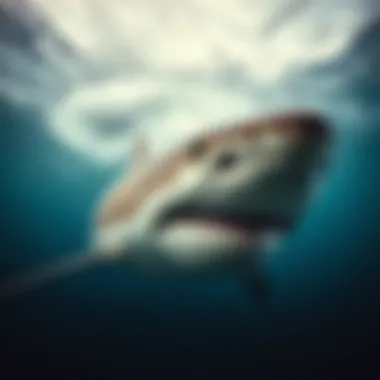
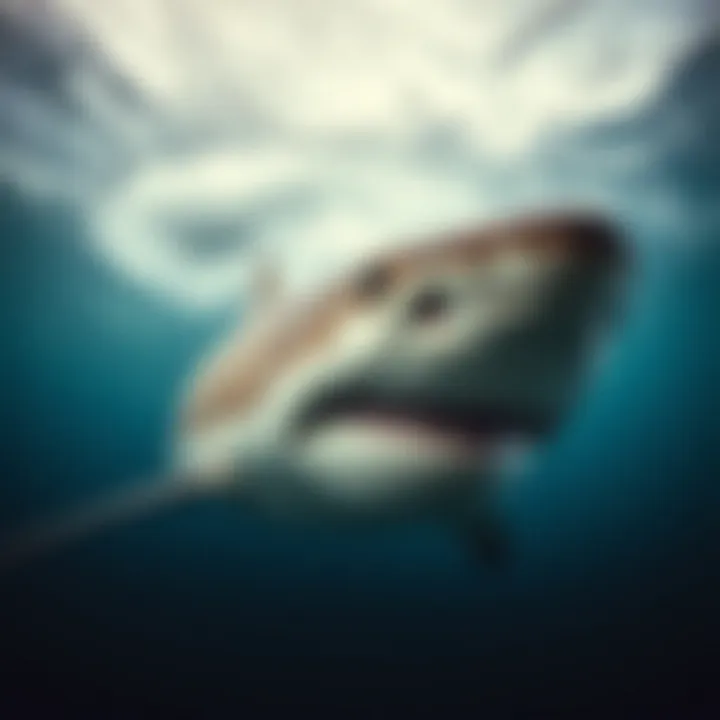
"The ocean is their home, but every once in a while, they wander into ours. Respect goes a long way."
Safety Measures for Surfers
Safety is paramount when engaging in surfing, especially in regions known for shark sightings. Knowledge and precaution can greatly enhance the surfing experience without fear overshadowing the thrill. Here are several practical safety measures:
- Stay Informed: Keep abreast of local shark activity reports. Some coastal communities provide apps or websites that track sightings and give real-time updates.
- Avoid Wearing Bright Colors: Just like other forms of wildlife, sharks are drawn to contrasts. Wearing muted or darker colors can help minimize attention which, while it sounds odd, can aid in reducing visibility.
- Avoid Splashing and Erratic Movements: Quick movements can mimic the injured prey that sharks find irresistible. Swimming smoothly and calmly can vastly improve safety.
- Be Cautious After Rainfall: Heavy rains can wash a lot of fish and nutrients into the ocean, which can attract sharks close to shore. Avoiding post-storm swims or paddles can be a smart move.
- Avoid Surfing Alone: As stated earlier, there's strength in numbers. Other surfers or lifeguards can provide assistance if needed, which is always a comfort.
These measures might seem common-sense, but they reinforce a relationship characterized by respect rather than fear. As surfers take to the waves, they’re not just riding the swells; they’re co-existing in a blue world where sharks thrive — living embodiments of the ocean's raw energy.
Conservation Efforts
Conservation efforts aimed at protecting sharks have become increasingly vital in recent years. These creatures, often misunderstood, are critical to the health of marine ecosystems. With ongoing threats like overfishing and habitat destruction, it’s essential to take action to ensure their survival, which in turn supports biodiversity and the overall balance of ocean life.
Threats Facing Shark Populations
Sharks face numerous challenges that imperil their existence. Even though these animals have roamed the seas for hundreds of millions of years, their future is precarious due to several pressing threats:
- Overfishing: Sharks are often caught unintentionally as bycatch in commercial fishing operations. Their slow reproduction rates make it difficult for populations to recover from such losses.
- Shark Finning: The practice of removing fins and discarding the bodies at sea not only raises ethical concerns but also endangers entire populations. Many species are pushed to the brink for this lucrative market.
- Habitat Loss: Coastal development, pollution, and climate change lead to the degradation of essential habitats such as coral reefs and mangroves, which are crucial for shark breeding and nursery grounds.
- Pollution: Chemical contaminants from human activities can accumulate in shark tissues, affecting their health and reproductive abilities, ultimately impacting their populations.
Addressing these threats requires a concerted global effort, understanding shark biology, behavior, and habitats to implement effective conservation strategies.
Global Initiatives for Shark Protection
Across the globe, various initiatives aim to protect sharks and restore their populations. These efforts represent collaboration among governments, non-profits, scientific communities, and local communities. Here are some key initiatives:
- Regulatory Frameworks: Many countries and regions have implemented laws regulating shark fishing and trade. Institutions like the Convention on International Trade in Endangered Species (CITES) help manage and protect specific shark species.
- Shark Sanctuaries: Some nations have established shark sanctuaries where fishing for sharks is banned or strictly regulated, allowing populations to recover. For instance, Palau created one of the world's largest shark reserves, demonstrating a commitment to marine conservation.
- Research Initiatives: Collaborative studies focusing on shark behavior and population dynamics guide effective management strategies. Organizations like the Shark Research Institute conduct vital research that informs conservation practices.
- Public Awareness Campaigns: Educating the public about the ecological importance of sharks and the threats they face is crucial. Programs and social media campaigns aim to dispel myths and garner support for shark conservation, promoting responsible fishing practices.
"The future of sharks depends on our ability to adapt and change our ways. Only together can we create a healthier ocean environment for them and ourselves."
The Future of Sharks
The future of sharks is an increasingly pressing topic in marine conservation discourse, especially given their role as keystone species in maintaining biodiversity within oceanic ecosystems. Understanding the trajectory of shark populations not only holds implications for marine life but also for those who engage with marine environments—like surfboarders and ocean enthusiasts—who have a vested interest in healthy marine ecosystems.
Given the significant threats facing sharks—overfishing, habitat loss, and climate change—effective conservation strategies must be developed and implemented. Each of these elements brings its own challenges and opportunities for future shark populations.
Research and Discoveries
The ongoing research into the behaviors and habitats of sharks provides invaluable insights that can guide protective measures. Recent studies reveal that the migratory patterns of certain shark species are influenced more by environmental conditions than previously understood. For example, researchers have tracked the Great White Shark's movements along the California coast, finding that shifts in ocean temperatures can significantly modify their routes and feeding habits. The continued examination of these patterns is crucial for setting up marine protected areas and understanding how changes in the ocean's health can directly impact shark populations.
Moreover, advancements in genetic research allow scientists to track genetic diversity in shark populations. This data is vital for assessing the health of species and understanding their resilience to environmental stresses. Insights from these studies help pinpoint breeding grounds and areas needing stricter protections, ensuring the sustainability of shark populations.
Innovative Technologies in Shark Studies
Technological advancements have revolutionized the field of marine biology, providing new tools for tracking and studying sharks in their natural environment. For instance, satellite tagging and acoustic monitoring allow researchers to collect real-time data on shark movements and behavior. With these methods, scientists can gain clearer pictures of sharks' migratory routes and breeding sites, shedding light on their often-understated role in marine ecosystems.
Additionally, artificial intelligence is being applied to analyze vast amounts of ecological data. This technology helps in predicting behavioral trends based on environmental shifts, enabling more proactive conservation measures. Tools such as drones and underwater robots also enhance the scope of marine research, allowing for deeper exploration of shark habitats that were previously difficult to reach.
Through these innovative methods, from genetic studies to advanced tracking technologies, the realm of shark research continues to evolve. As these discoveries unfold, they instill a sense of hope that informed conservation strategies can effectively address the challenges sharks face in a rapidly changing world.
"Sharks are often misunderstood, but they play an essential role in the ocean ecosystem. Research remains critical to their future survival."
In closing, the future of sharks is not solely a matter for marine biologists or conservationists—it's a collective responsibility. As surfboarders and ocean lovers, the acknowledgment of these scientific advancements can help foster a connection to the marine environment, encouraging individuals to advocate for sustainable practices that protect these remarkable creatures.
The End
The conclusion of this article plays a vital role in encapsulating the richness of the information presented about sharks. It serves as a final word, weaving together the multifaceted dimensions of these creatures that often occupy a nebulous spot in public perception. While sharks are often depicted as fearsome predators in media, a closer look reveals their critical function within marine ecosystems and highlights their significance to biodiversity.
The key takeaway is the importance of synergizing our understanding of sharks with responsible interaction, especially for surfboarding enthusiasts and the broader community. Realizing the ecological value these animals provide — such as maintaining the balance of marine life — is paramount. By fostering respect and awareness, we not only protect sharks but also contribute to healthier oceans.
"In every ripple of the ocean, there exists a story of balance, survival, and evolution, and sharks are integral to that narrative."
As we wrap up the discussion, it's essential to acknowledge that sharks are not just survivors of evolution; they're crucial entities of our marine world. Their decline has far-reaching implications for ocean health, which directly affects recreational and commercial activities intertwined with marine life. Everyone, from surfboarders to casual beachgoers, stands to benefit from supporting conservation efforts and advocating for sustainable practices. The fate of sharks, and by extension, our oceans, rests not solely on science but also on our societal choices and actions.
Summation of Key Insights
To summarize, here are a few critical insights that emerged from the article:
- Sharks play an essential role as apex predators, influencing the structure of marine ecosystems.
- They have an evolutionary history that dates back hundreds of millions of years, showcasing their adaptability and resilience.
- Dispelled myths and misconceptions empower us to appreciate sharks beyond the stigma often associated with them.
- Education and responsible interactions can significantly contribute to their protection and conservation efforts.
Understanding these points not only heightens our awareness about their ecological importance but also emphasizes the necessity of safeguarding their existence for future generations.
Encouraging Responsible Interaction
Encouraging responsible interaction with sharks calls for a multifaceted approach. Surfboarders, divers, and other ocean enthusiasts must adopt the following measures:
- Educate Yourself: Familiarize yourself with shark species native to your surf spots. Understanding their behaviors and habitats will increase your safety and appreciation for these creatures.
- Respect Their Space: If a shark is sighted, keep a respectful distance. Avoid splashing or making sudden movements that could mimic distressed prey, enhancing the chance of an encounter.
- Participate in Conservation: Join groups dedicated to shark protection or support initiatives aimed at ensuring their habitats remain healthy. These actions help balance the integrity of marine ecosystems.
- Share Knowledge: Talk about sharks with friends and family, especially within surf communities, to spread positivity and awareness regarding these essential creatures.













